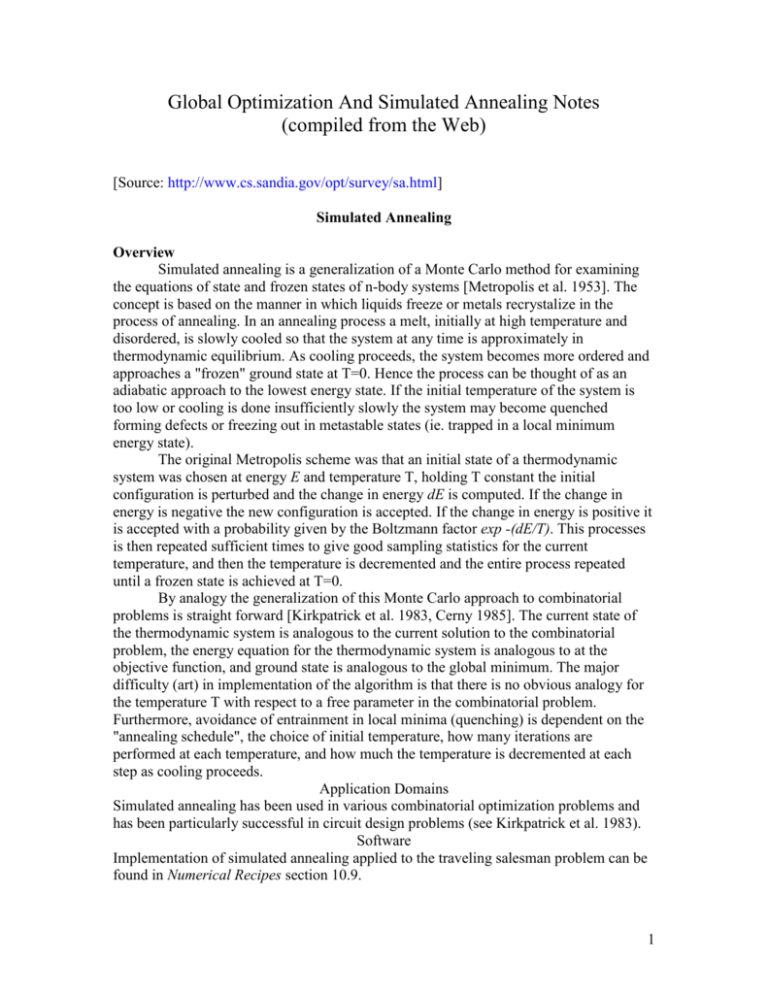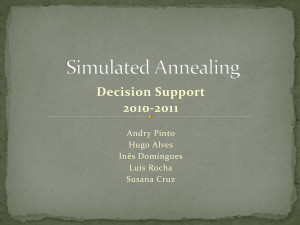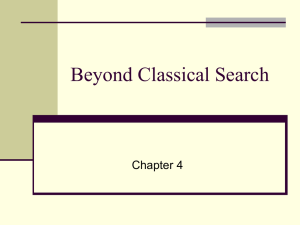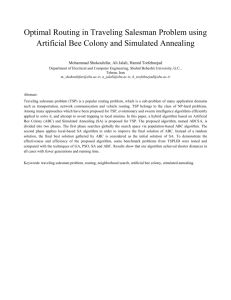
Global Optimization And Simulated Annealing Notes
(compiled from the Web)
[Source: http://www.cs.sandia.gov/opt/survey/sa.html]
Simulated Annealing
Overview
Simulated annealing is a generalization of a Monte Carlo method for examining
the equations of state and frozen states of n-body systems [Metropolis et al. 1953]. The
concept is based on the manner in which liquids freeze or metals recrystalize in the
process of annealing. In an annealing process a melt, initially at high temperature and
disordered, is slowly cooled so that the system at any time is approximately in
thermodynamic equilibrium. As cooling proceeds, the system becomes more ordered and
approaches a "frozen" ground state at T=0. Hence the process can be thought of as an
adiabatic approach to the lowest energy state. If the initial temperature of the system is
too low or cooling is done insufficiently slowly the system may become quenched
forming defects or freezing out in metastable states (ie. trapped in a local minimum
energy state).
The original Metropolis scheme was that an initial state of a thermodynamic
system was chosen at energy E and temperature T, holding T constant the initial
configuration is perturbed and the change in energy dE is computed. If the change in
energy is negative the new configuration is accepted. If the change in energy is positive it
is accepted with a probability given by the Boltzmann factor exp -(dE/T). This processes
is then repeated sufficient times to give good sampling statistics for the current
temperature, and then the temperature is decremented and the entire process repeated
until a frozen state is achieved at T=0.
By analogy the generalization of this Monte Carlo approach to combinatorial
problems is straight forward [Kirkpatrick et al. 1983, Cerny 1985]. The current state of
the thermodynamic system is analogous to the current solution to the combinatorial
problem, the energy equation for the thermodynamic system is analogous to at the
objective function, and ground state is analogous to the global minimum. The major
difficulty (art) in implementation of the algorithm is that there is no obvious analogy for
the temperature T with respect to a free parameter in the combinatorial problem.
Furthermore, avoidance of entrainment in local minima (quenching) is dependent on the
"annealing schedule", the choice of initial temperature, how many iterations are
performed at each temperature, and how much the temperature is decremented at each
step as cooling proceeds.
Application Domains
Simulated annealing has been used in various combinatorial optimization problems and
has been particularly successful in circuit design problems (see Kirkpatrick et al. 1983).
Software
Implementation of simulated annealing applied to the traveling salesman problem can be
found in Numerical Recipes section 10.9.
1
[Source: http://members.aol.com/btluke/simann1.htm]
Simulated Annealing
Brian T. Luke, Ph.D.
LearningFromTheWeb.net
A simple Monte Carlo simulation samples the possible states of a system by randomly
choosing new parameters. At the end of the simulation, the collection, or ensemble, of
randomly chosen points in search space gives you information about about this space.
For example, the web page Simple Monte Carlo Simulation gives an example of a unit
square containing one-quarter of a unit circle whose center is in the lower left corner. The
search space is the unit square, and any point in this space can be in one of two possible
states; inside of the quarter-circle, or outside. Each point in the search space is
determined by the value of two parameters, its x- and y-coordinate. The possible values
for each parameter can be any real number in the range [0.0,1.0]. Each step in the
simulation consists of choosing random, allowed values for both of the parameters. This
generates a point in the search space that is associated with one of the two states. At the
end of the simulation, there will be an ensemble of N points, of which Nin are inside of
the quarter-circle. The ratio of Nin to N is just the ratio of the area inside the quarter-circle
to the area of the unit square.
Therefore, a simple Monte Carlo simulation randomly selects a point somewhere
is the search space and all points are used to find out information about the search space.
This procedure has use in some problems, like the one described above for finding the
area of certain regions, but does not give physically realistic results when the search
space represents an energy surface.
For example, assume that the simulation studies a collection of M helium atoms in
a cube. The position of each atom is described by three parameters that give its
coordinates within the cube. The energy of this system is given by the sum of all pairwise interaction energies. If you wanted to calculate the average energy of this system, a
simple Monte Carlo simulation should not be used. This is because a random placement
of the M atoms may, at some point of the simulation, place two of the atoms so close
together that their interaction energy is virtually infinite. This adds an infinite energy to
the ensemble of atom distributions and produces an infinite average energy.
In the real world, two helium atoms would never get that close together. Therefore, a
modification to the simple Monte Carlo simulation needs to be made so that unrealistic
samples are not placed into the ensemble. Such a modification was proposed in 1953 by
Nicholas Metropolis and coworkers [1]. This modified procedure is known as a
Metropolis Monte Carlo simulation.
In contrast with the simple Monte Carlo simulation, a new point in search space is
sampled by making a slight change to the current point. In the example used here, a new
orientation of the helium atoms is created by making a random, small change to each
atom's coordinates. If the energy of this new orientation is less than that of the old, this
orientation is added to the ensemble. If the energy rises, a Boltzmann acceptance criteria
is used. If the energy rise is small enough, the new orientation is added to the ensemble.
2
Conversely, if the energy rise is too large, the new orientation is rejected and the old
orientation is again added to the ensemble (see Metropolis Monte Carlo Simulation for
more details).
By using this acceptance probability one can prove that the average of any
property, such as the energy, over the ensemble is equal to the Boltzmann average of this
property as determined by the Boltzmann Distribution Law, for a sufficiently large
ensemble. What is unique about this Boltzmann acceptance probability is that the
temperature of the system must be used. Therefore, the Boltzmann average of a property
is the expected value of this property at the given temperature.
In 1983, Kirkpatrick and coworkers [2] proposed a method of using a Metropolis Monte
Carlo simulation to find the lowest energy (most stable) orientation of a system. Their
method is based upon the procedure used to make the strongest possible glass. This
procedure heats the glass to a high temperature so that the glass is a liquid and the atoms
can move relatively freely. The temperature of the glass is slowly lowered so that at each
temperature the atoms can move enough to begin adopting the most stable orientation. If
the glass is cooled slowly enough, the atoms are able to "relax" into the most stable
orientation. This slow cooling process is known as annealing, and so their method is
known as Simulated Annealing.
A Simulated Annealing optimization starts with a Metropolis Monte Carlo
simulation at a high temperature. This means that a relatively large percentage of the
random steps that result in an increase in the energy will be accepted. After a sufficient
number of Monte Carlo steps, or attempts, the temperature is decreased. The Metropolis
Monte Carlo simulation is then continued. This process is repeated until the final
temperature is reached.
A Simulated Annealing program consists of a pair of nested DO-loops. The outermost loop sets the temperature and the inner-most loop runs a Metropolis Monte Carlo
simulation at that temperature. The way in which the temperature is decreased is known
as the cooling schedule. In practice, two different cooling schedules are predominantly
used; a linear cooling schedule (Tnew=Told-dT) and a proportional cooling schedule
(Tnew=C×Told) where C<1.0. These are not the only possible cooling schedules, they are
just the ones that appear the most in the literature. Other possible cooling schedules are
shown in Figure 1. To hopefully make this whole process clearer, Figure 2 presents a
flow chart of a Simulated Annealing run, with explanation.
As described in more detail in the discussion of a Metropolis Monte Carlo
simulation, a more difficult aspect is to determine who long to run this simulation at each
temperature. This depends upon the maximum size of the Monte Carlo step at each
temperature. While a pure Metropolis Monet Carlo simulation attempts to reproduce the
correct Boltzmann distribution at a given temperature, the inner-loop of a Simulated
Annealing optimization only needs to be run long enough to explore the regions of search
space that should be reasonably populated. This allows for a reduction in the number of
Monte Carlo steps at each temperature, but the balance between the maximum step size
and the number of Monte Carlo steps is often difficult to achieve, and depends very much
on the characteristics of the search space or energy landscape.
References:
[1] N. Metropolis, A.W. Rosenbluth, M.N. Rosenbluth. A.H. Teller and E. Teller, J.
3
Chem. Phys. 21 (1953) 1087-1092.
[2] S. Kirkpatrick, C.D. Gelatt and M.P. Vecchi, Science 220 (1983) 671-680.
[Source: http://emlab.berkeley.edu/Software/abstracts/goffe895.html]
Simulated Annealing - Global Optimization Method That Distinguishes Between
Different Local Optima
Author: William Goffe
Copyright (c) 1995. William Goffe. All Rights Reserved.
Keywords: simulated annealing, optimization
Reference: This implementation of simulated annealing was used in "Global
Optimization of Statistical Functions with Simulated Annealing," Goffe, Ferrier and
Rogers, Journal of Econometrics, vol. 60, no. 1/2, Jan./Feb. 1994, pp. 65-100. Briefly, we
found it competitive, if not superior, to multiple restarts of conventional optimization
routines for difficult optimization problems.
Description: Simulated annealing is a global optimization method that distinguishes
between different local optima. Starting from an initial point, the algorithm takes a step
and the function is evaluated. When minimizing a function, any downhill step is accepted
and the process repeats from this new point. An uphill step may be accepted. Thus, it can
escape from local optima. This uphill decision is made by the Metropolis criteria. As the
optimization process proceeds, the length of the steps decline and the algorithm closes in
on the global optimum. Since the algorithm makes very few assumptions regarding the
function to be optimized, it is quite robust with respect to non-quadratic surfaces. The
degree of robustness can be adjusted by the user. In fact, simulated annealing can be used
as a local optimizer for difficult functions.
Platforms: Fortran
[Source: http://www-2.cs.cmu.edu/afs/cs/project/ai-repository/ai/areas/anneal/asa/0.html]
ASA: Adaptive Simulated Annealing
areas/anneal/asa/
ASA (Adaptive Simulated Annealing) is a powerful global optimization
C-code algorithm especially useful for nonlinear and/or stochastic
systems.
ASA is developed to statistically find the best global fit of a
nonlinear non-convex cost-function over a D-dimensional space. This
algorithm permits an annealing schedule for 'temperature' T decreasing
exponentially in annealing-time k, T = T_0 exp(-c k^1/D). The
introduction of re-annealing also permits adaptation to changing
sensitivities in the multi-dimensional parameter-space. This annealing
schedule is faster than fast Cauchy annealing, where T = T_0/k, and
much faster than Boltzmann annealing, where T = T_0/ln k.
4
Origin:
ftp.alumni.caltech.edu:/pub/ingber/ASA.tar.gz [131.215.48.62]
References
Cerny, V., "Thermodynamical Approach to the Traveling Salesman Problem: An
Efficient Simulation Algorithm", J. Opt. Theory Appl., 45, 1, 41-51, 1985
Kirkpatrick, S., C. D. Gelatt Jr., M. P. Vecchi, "Optimization by Simulated
Annealing",Science, 220, 4598, 671-680, 1983.
Metropolis,N., A. Rosenbluth, M. Rosenbluth, A. Teller, E. Teller, "Equation of State
Calculations by Fast Computing Machines", J. Chem. Phys.,21, 6, 1087-1092, 1953.
Press, Wm. H., B. Flannery, S. Teukolsky, Wm. Vettering, Numerical Recipes, 326-334,
Cambridge University Press, New York, NY, 1986.
[Source: ftp://ftp.taygeta.com/pub/publications/anneal.refs]
Simulated Annealing References
Caceci, M.S. and W. P. Cacheris, 1984; Fitting Curves to Data, BYTE,
May, pp. 340 - 362
Kirkpatrick, S., C.D. Gelatt Jr, and M.P. Vecchi, 1983; Optimization by
Simulated Annealing, Science, V. 220, No. 4598, pp. 671 - 680
MacDougall, M.H., 1987; Simulating Computer Systems, Techniques and Tools,
M.I.T. Press, Cambridge Mass., 284 pages
McCalla, 1967; Introduction to Numerical Methods and FORTRAN Programming,
John Wiley & Sons, New York
McClelland, J.L. and D.E. Rumelhart, 1988; Explorations in Parallel Distributed
Processing, A Handbook of Models, Programs, and Exercises, M.I.T. Press,
Cambridge Mass., 344 pages
Metropolis, N., A.W. Rosenbluth, M.N. Rosenbluth, A.H. Teller and
E. Teller, 1953; Equation of State Calculations by Fast Computing
Machines, J. Chem. Phys., V 21, No. 6, pp. 1087 - 1092
Press, W.H., B.P. Flannery, S.A. Teukolsky and W.T. Vetterling, 1986;
Numerical Recipes, The Art of Scientific Computing, Cambridge Univ. Press,
Cambridge England, 818 pages
Rumelhart, D.E. and J.L. McClelland, 1986; Parallel Distributed Processing,
Explorations in the Microstructure of Cognition, Volume 1: Foundations,
5
M.I.T. Press, Cambridge Mass., 547 pages
Szu, H. and R. Hartley, 1987; Fast Simulated Annealing, Physics Letters A,
Vol. 122, No. 3,4, pp. 157 - 162
Wasserman, P.D., 1989; Neural Computing, Theory and Practice, Van Nostrand
Reinhold, New York, 230 pages
http://www.nutechsolutions.com/technology/genetic_algorithms.asp
Genetic Algorithms
The entire research area of Genetic Algorithms, as well as that of Evolutionary
Computing, was inspired by Darwin's theory of natural selection and survival of the
fittest. Genetic algorithms are problem-solving programs that try to mimic the way large
populations solve problems over a long period of time, through processes such as
reproduction, mutation, and natural selection. To emulate the natural phenomenon of
evolution, a genetic algorithm program creates a population of candidate solutions to a
particular problem, and through a process of random selection and variation, each
generation of the program improves upon the quality of the solution. Consequently,
genetic algorithms promote the evolution of solutions by using genetically based
processes. Unlike natural evolution, the program is usually able to generate and evaluate
thousands of generations in seconds.
Useful Links
Global Optimization: http://www.mat.univie.ac.at/~neum/glopt.html
Contains discussions (and code) for a wide variety of global optimization
procedures, including simulated annealing...
A Survey of Global Optimization Methods:
http://www.cs.sandia.gov/opt/survey/main.html
Just what it says, but more readable than the site listed above...
Global Optimization: http://www.fi.uib.no/~antonych/glob.html
Another site that lists journals, and lots of links...
Simulated Annealing - Global Optimization Method That Distinguishes Between
Different Local Optima
http://emlab.berkeley.edu/Software/abstracts/goffe895.html
This is the source code from the Goffe et al. 1994 citation that I used as the basis
for the simulated annealing code that I have implemented in Delphi.
Numerical Recipes Homepage: http://www.nr.com/
Homepage for the popular series of programs in C, Pascal, etc.
6
Numerical Recipes in Pascal:
http://archives.math.utk.edu/software/msdos/numerical.analysis/nrpas13/.html
This link will take you to a download of all of the programs from the diskette
accompanying the Pascal version of Numerical Recipes
7










